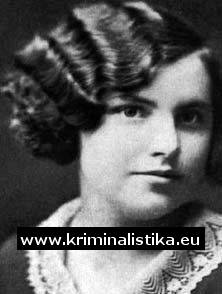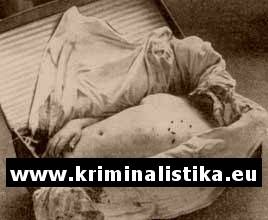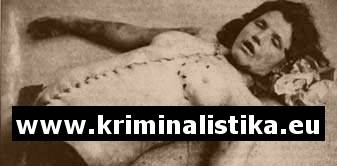Otýlie Vranská
Born on March 9th, 1911 - murdered on September 1st, 1933

The murder of the street-girl, Otýlie Vranská, is one of the well-known crimes in the history of the Czech criminology. The murderer - despite the policemen's great anxiety - has never been found out. And thus, a great number of murderer theories came into existence and people were fond of talking about them for many years. Any murder where a human body cut into pieces occurs has been compared to that murder up to the present day...
There are found two pieces of luggage containing parts of a human body at the railway stations in Bratislava and Košice on Semptember 2nd, 1933. According to the accompanying documents, they were sent from Prague, each of them from a different railway station (Wilson Railway Station, Masaryk Railway Station) a day before. The autopsy proves that the parts are from a body of a woman who was killed with two strikes in her head, probably a meat chopper. The head was cut off with a sharp instrument immediately. The same instrument, probably a knife, was used to jab at the dead and headless body seven times. The woman had eaten an apple one or two hours before she was murdered...
Parts of a human body found in one suitcase

On Monday, Semptember 4th, 1933, at 8:OO a. m., the Prague Police Headquarters displays the two pieces of luggage, including the sheet and leaflets the body was wrapped in, in order to find somebody who can give some more details about those things, especially about the owner of the luggage. The repair of one of the suitcases was done workmanly. What is more, the luggage was transported from the scene of crime to two different places. Somebody (taxi drivers, railway station staff, conductors...) might notice a person carrying the luggage.
Thousands of people visit the display and thus it is rather difficult to keep the public order. The photographs of the luggage and the head are released in every newspaper. Two women from Slovakia annonouce that it is their sister - Otýlie Vranská - on the photographs. Police find out that Otýlie Vranská earned her living as a street-girl in Prague.
The parts of a human body found in the second luggage

Police find out: Otýlie Vranská eats the apple in a café short before the midnight. One hour later, she is seen at the door of a restaurant. Although being there very often, she does not enter. She meets her future - still unknown - murderer a few minutes later.
During the police investigations, Police receive nearly 5,000 - mainly authorless - letters and "one-hundred-per-cent guaranteed information" about the murderer(s). Every information is checked thoroughly. Unfortunately, it is a great opportunity for many people to come down upon their neighbours or people they are not fond of. An authorless letter even blames on a Prague eminent surgeon, a friend of the President T. G. Masaryk's. The very last authorless letter with the name of the murderer is delivered to Police in 1966 - 33 years later...
The "complete" body after the autopsy

From the professional-experience point of view and in connection with similar cases, the popularity of Otýlie Vranská seems to be rather doubtful. Defensive quartation of the victims of murderous attacks is nothing extraordinary. Lots of murderers (including female murderers) try to conceal or make difficult for clearing up their crime that way. For example, in January 1995, hot-blooded Ilona Skalická, living in Liberec, murders her husband and cuts his body into ten pieces. Then she loads up the parts of the body on a children's bobsleigh and throws them into several dustbins. In the contrary to the Vranská murderer, she is detected and sentenced to six years in prison. Short after that, the then-president Václav Havel amnesties her...
The headlines in the contemporary newspaper

The stab wounds round the left breast, done after cutting the head off, show that the Vranská murderer was possible to be hot blooded (maybe even drunk) too. Then he behaved rationaly trying to conceal the consequences of his crime. He was not suffering from either any sex-aggression or any mental defect because he did not repeat such a thing any more. It is also possible that the murderer was a woman.
It was journalists and their, sometimes nonsensical, articles on the possible murderer and his motive. They were not willing to admit any other possibility but only their idea of "a street killer". Otherwise, clouds would blow over the "Vranská case" completely the same way they did over tens of similar, sometimes much more serious, offenderless crimes.
© Miloslav Jedlička, D. C. L.
Translated by inspector WO Pavel Vršovský, M. A.